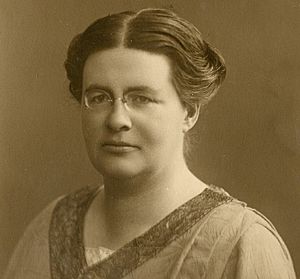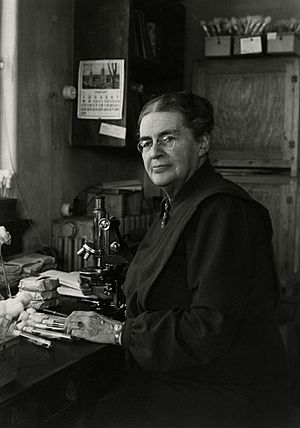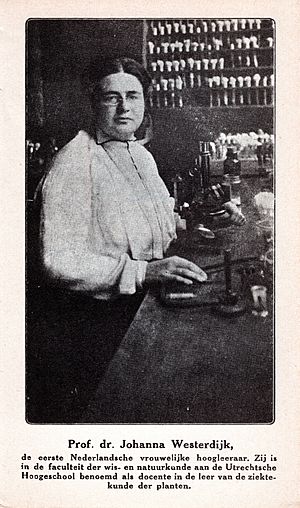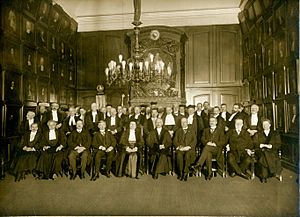Johanna Westerdijk facts for kids
Quick facts for kids
Johanna Westerdijk
|
|
|---|---|
 |
|
| Born | 4 January 1883 |
| Died | 15 November 1961 (aged 78) Baarn, Netherlands
|
| Alma mater | University of Amsterdam University of Munich University of Zurich (PhD) |
| Scientific career | |
| Fields | Plant pathology |
| Institutions | Utrecht University University of Amsterdam |
| Doctoral advisor | Hans Schinz |
| Doctoral students | Marie Beatrice Schol-Schwarz; Maria Löhnis; Johan Gerard ten Houten |
| Author abbrev. (botany) | Westerd. |
Johanna Westerdijk (4 January 1883 – 15 November 1961) was a Dutch plant pathologist. She was also the first female professor in the Netherlands.
Contents
Early Life and Interests
Johanna Westerdijk was born on 4 January 1883. Her birthplace was Nieuwer-Amstel, a small village near Amsterdam. Friends often called her "Hans." She passed away on 15 November 1961, at 78 years old, in Baarn, Netherlands.
Johanna grew up in a well-off family that valued learning and art. Her parents were Bernard Westerdijk and Aleida Catharina Scheffer. Johanna was the oldest of three children. Even as a young girl, she showed an independent spirit. She preferred reading stories to other girls instead of traditional activities like embroidery or playing with dolls. She once told her teacher that she would earn enough money to have others do her cleaning chores. This showed her early ambition!
Education and Discoveries
Johanna finished secondary school at 17. She graduated from an all-girls school in Amsterdam. She was a very talented pianist and hoped to become a professional musician. However, a problem with her arm, called neuritis, made this dream impossible.
Her interest then turned to botany, the study of plants. She went to Amsterdam University to learn from the famous botanist Hugo de Vries. She also worked in his laboratory.
After studying biology, she went to Munich in 1904 to research mosses. A year later, she moved to Zurich. There, she continued studying how mosses grow back. She earned her PhD degree in 1906, guided by Professor H. Schinz.
A Pioneering Career
In 1906, at just 23 years old, Johanna was offered an important job. She became the director of the Willie Commelin Scholten, a plant disease laboratory in the Netherlands. Under her leadership, this laboratory became a respected place for studying plant diseases around the world. It moved to Villa Java in Baarn and is still an independent institute today.
In 1908, while leading the laboratory, she also took charge of a collection of about 80 types of fungi. This collection belonged to the International Association of Botanists. Under her care, this collection grew hugely! It expanded to more than 10,000 types of 6,000 different fungi, yeasts, and similar organisms. This collection was named the Centraalbureau voor Schimmelcultures (Central Bureau of Fungal Cultures). Its goal was, and still is, to keep a variety of fungi for researchers worldwide.
In 1913, she received a grant from the Buitenzorg Fund. She used this money to collect samples from sick crops like tobacco, sugar, coffee, and tea. She then grew cultures of the fungi from these samples for the collection. Throughout her career, she wrote over 60 scientific papers about plant diseases and mycology (the study of fungi).
Inspiring Others
In 1917, Johanna Westerdijk made history. She became the first female professor in the Netherlands! She worked as an associate professor of plant pathology at Utrecht University. Later, in 1930, she also became a professor at the University of Amsterdam. Over 35 years, she guided 55 students to earn their PhD degrees. Almost half of these students were women. She truly inspired many students interested in science, especially women.
She published over 70 papers on many plant diseases and fungi. Her main interest was in diseases that harm trees and how to control them. Some of her research involved testing chemicals to fight plant diseases.
Journalists described Johanna Westerdijk as a young, natural, and strong woman. She had a pleasant way about her and a great sense of humor. She was known for her lively personality.
Johanna had unique ways of teaching and celebrating. To test her students, she would take them to a fancy bakery. There, surrounded by fashionable people, she would suddenly ask them tough questions about plant diseases! She also had a special tradition for every new PhD ceremony. A flag would be raised, and three geese wearing white, red, and blue bows would parade around the building. The new doctor and their professor would then plant a tree in the garden. This tradition became very famous.
Everyone who worked on their PhD at Baarn felt inspired by the atmosphere. The laboratory had a special motto carved in stone above the entrance: "For fine minds, the art is to mix work and parties." This showed Johanna Westerdijk's belief in balancing hard work with fun.
Westerdijk was also active in the International Federation of University Women. She served as the president of this organization from 1932 to 1936.
Research on Elm Disease

In the 1920s, Johanna Westerdijk played a key role in understanding a new, deadly disease affecting elm trees. This disease is now known as Dutch elm disease. She raised money from different cities in the Netherlands to fund this research. She then gave this important task to her first PhD student, Marie Beatrice Schwarz.
Schwarz studied healthy elm trees and found that a fungus was causing the disease. Later, Johanna assigned another student, Christine Johanna Buisman, to confirm Schwarz's findings. Buisman confirmed that Ophiostoma novo-ulmi was indeed the cause. Buisman also tried to breed elm trees that could resist the disease. However, the elm tree she developed later turned out to be easily affected by another fungal disease.
Honors and Awards
Johanna Westerdijk received many honors for her important work:
- Member of the Royal Netherlands Academy of Arts and Sciences (1951)
- Fellow of the Linnean Society of London
- Officer of the Order of Orange-Nassau
- Order of the Netherlands Lion
- Knight of the Order of Saint James of the Sword (Portugal)
- Otto Appel Medal (1953) (an award for outstanding plant pathologists)
- Honorary doctorate from Uppsala University (1957)
- Honorary doctorate from the University of Giessen (1958)
Eponymous Species
Several types of fungi have been named in honor of Johanna Westerdijk, showing her lasting impact on science:
- Aspergillus westerdijkiae Frisvad & Samson (2004)
- Helicodendron westerdijkiae Beverw. (1953)
- Pestalotiopsis westerdykiae Steyaert (1949)
- Gyrothyrium westerdijkiae Arx (1950) (now called Schizothyrium pomi)
- Torulopsis westerdijkiae E. K. Novák & Vitéz (1964)
- Westerdykella centenaria Crous, van Diepeningen & A.-C. Normand (2017)
Legacy
In 1907, Johanna Westerdijk became the director of the CBS (Centraalbureau voor Schimmelcultures). To honor her life and work, on 10 February 2017, this institute was renamed the Westerdijk Fungal Biodiversity Institute. This shows how important her contributions were to the study of fungi and plant diseases.




